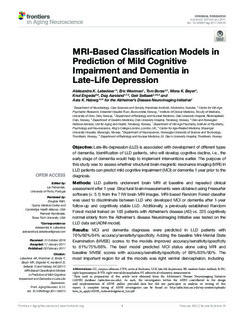| dc.contributor.author | Lebedeva, Aleksandra K. | |
| dc.contributor.author | Westman, Eric | |
| dc.contributor.author | Borza, Tom | |
| dc.contributor.author | Beyer, Mona K. | |
| dc.contributor.author | Engedal, Knut | |
| dc.contributor.author | Aarsland, Dag | |
| dc.contributor.author | Selbæk, Geir | |
| dc.contributor.author | Håberg, Asta | |
| dc.date.accessioned | 2017-06-22T09:33:52Z | |
| dc.date.available | 2017-06-22T09:33:52Z | |
| dc.date.created | 2017-03-21T14:14:50Z | |
| dc.date.issued | 2017 | |
| dc.identifier.citation | Frontiers in Aging Neuroscience. 2017, 9:13 1-11. | nb_NO |
| dc.identifier.issn | 1663-4365 | |
| dc.identifier.uri | http://hdl.handle.net/11250/2446671 | |
| dc.description.abstract | Objective: Late-life depression (LLD) is associated with development of different types of dementia. Identification of LLD patients, who will develop cognitive decline, i.e., the early stage of dementia would help to implement interventions earlier. The purpose of this study was to assess whether structural brain magnetic resonance imaging (MRI) in LLD patients can predict mild cognitive impairment (MCI) or dementia 1 year prior to the diagnosis. Methods: LLD patients underwent brain MRI at baseline and repeated clinical assessment after 1-year. Structural brain measurements were obtained using Freesurfer software (v. 5.1) from the T1W brain MRI images. MRI-based Random Forest classifier was used to discriminate between LLD who developed MCI or dementia after 1-year follow-up and cognitively stable LLD. Additionally, a previously established Random Forest model trained on 185 patients with Alzheimer’s disease (AD) vs. 225 cognitively normal elderly from the Alzheimer’s disease Neuroimaging Initiative was tested on the LLD data set (ADNI model). Results: MCI and dementia diagnoses were predicted in LLD patients with 76%/68%/84% accuracy/sensitivity/specificity. Adding the baseline Mini-Mental State Examination (MMSE) scores to the models improved accuracy/sensitivity/specificity to 81%/75%/86%. The best model predicted MCI status alone using MRI and baseline MMSE scores with accuracy/sensitivity/specificity of 89%/85%/90%. The most important region for all the models was right ventral diencephalon, including hypothalamus. Its volume correlated negatively with the number of depressive episodes. ADNI model trained on AD vs. Controls using SV could predict MCI-DEM patients with 67% accuracy. Conclusion: LDD patients developing MCI and dementia can be discriminated from LLD patients remaining cognitively stable with good accuracy based on baseline structural MRI alone. Baseline MMSE score improves prediction accuracy. Ventral diencephalon, including the hypothalamus might play an important role in preservation of cognitive functions in LLD. | nb_NO |
| dc.language.iso | eng | nb_NO |
| dc.subject | Depresjon | nb_NO |
| dc.subject | Alzheimers sykdom | nb_NO |
| dc.subject | Hypotalamus | nb_NO |
| dc.title | MRI-based classification models in prediction of mild cognitive impairment and dementia in late-life depression | nb_NO |
| dc.type | Journal article | nb_NO |
| dc.type | Peer reviewed | nb_NO |
| dc.description.version | publishedVersion | nb_NO |
| dc.subject.nsi | VDP::Medisinske Fag: 700 | nb_NO |
| dc.source.pagenumber | 1-11 | nb_NO |
| dc.source.volume | 9:13 | nb_NO |
| dc.source.journal | Frontiers in Aging Neuroscience | nb_NO |
| dc.identifier.doi | 10.3389/fnagi.2017.00013 | |
| dc.identifier.cristin | 1460064 | |
| cristin.unitcode | 1991,9,1,0 | |
| cristin.unitname | Avd Alderspsykiatri | |
| cristin.ispublished | true | |
| cristin.fulltext | original | |
| cristin.qualitycode | 1 | |
